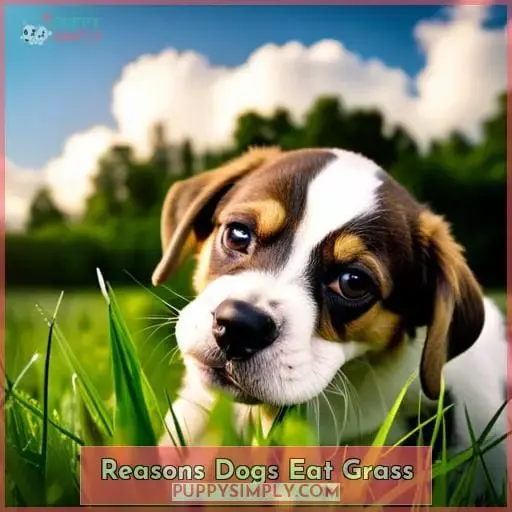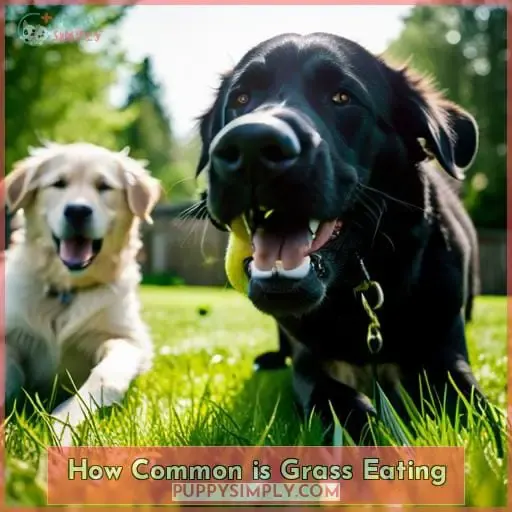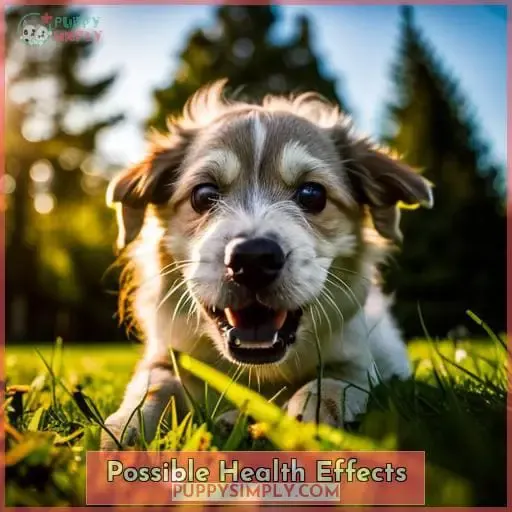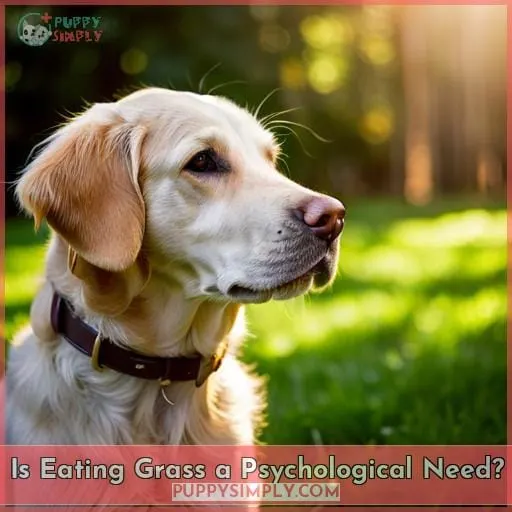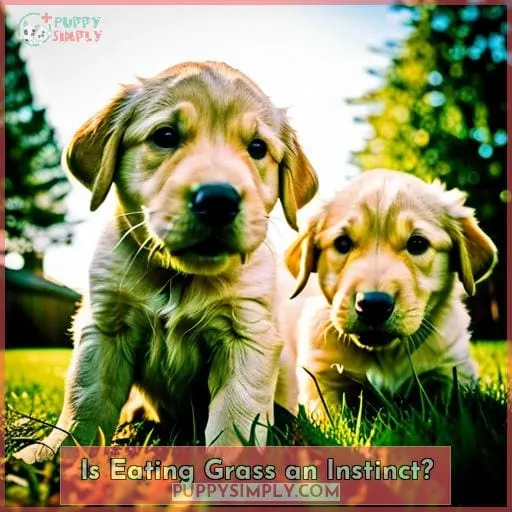This site is supported by our readers. We may earn a commission, at no cost to you, if you purchase through links.
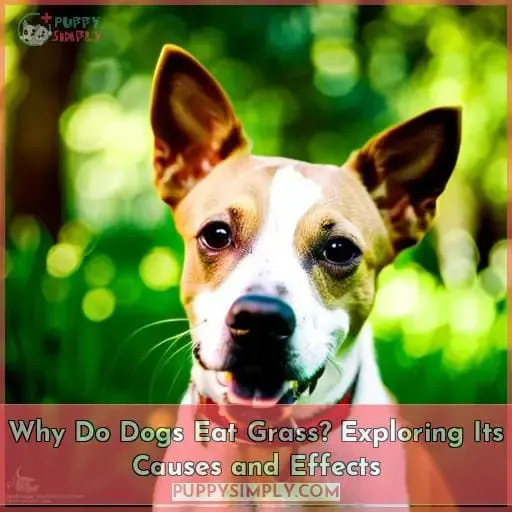 Confused as to why your furry friend is eating grass? You’re not alone. Many pet owners have found their dog munching on green leaves, and it can be worrying if they start vomiting afterward. Eating grass may indicate a nutritional deficiency or simply show that your pup is bored and seeking attention.
Confused as to why your furry friend is eating grass? You’re not alone. Many pet owners have found their dog munching on green leaves, and it can be worrying if they start vomiting afterward. Eating grass may indicate a nutritional deficiency or simply show that your pup is bored and seeking attention.
But what are the causes of this behavior and its effects? This article will explore various aspects of why dogs eat grass, from the percentage who do so to potential health risks you should look out for when managing this behavior in your pup.
Table Of Contents
Key Takeaways
- Dogs eating grass is a common behavior, with 10% of dogs showing signs of sickness before grazing.
- 25% of dogs vomit after ingesting vegetation, which is considered a normal behavior by veterinarians.
- Dogs may eat grass due to nutritional deficiencies, boredom, or to satisfy their grazing instinct from their wild ancestry.
- While grass can provide fiber and nutrients lacking in their diet, it is important to monitor for potential toxins and parasites in the environment.
Reasons Dogs Eat Grass
It’s fascinating to consider why dogs may eat grass. It could be due to a nutritional need, an instinctual grazing impulse carried over from their wild ancestry, or even simply because they enjoy the taste and texture.
Additionally, it could be out of boredom for attention-seeking or as a way of relieving anxiety and stress.
Nutritional Need
You may be surprised to hear that many of our furry friends turn to grass for a nutritional boost! Dogs can benefit from eating grass due to its balanced diet and the possibility it provides for relieving underlying health issues.
From designated grazing areas, they can get natural fiber as well as certain vitamins or minerals that may be lacking in commercial dog food. It’s also possible that dogs are seeking out specific nutrients through their instinctive behavior.
Nutritional need is an important reason why dogs eat grass, and knowing this could help with designing a healthy diet plan for them.
Grazing Instinct
Your pup’s inheriting a grazing instinct from their wild ancestors may be one of the reasons they’re drawn to grass. It’s not necessarily a bad idea for them to partake in this behavior, as the majority of grass that dogs eat is generally safe and healthy options.
Lots of dogs enjoy eating plants, so it’s important to pay attention if your dog eats grass regularly – especially if there are potential toxins or parasites present in it! You should also consider providing other food sources with essential vitamins and minerals as an alternative option for your pet instead of relying solely on grazing.
Taste and Texture Enjoyment
Experience the joy of sniffing and tasting a variety of grasses, as your pup indulges in their natural instinct to graze. Grass-eating may also be an enjoyable experience for modern dogs due to its taste and texture.
The crunchy textures can stimulate their senses. Certain types may have sweet or savory flavors that appeal to them.
While it’s important to monitor potential intestinal parasites or other medical conditions that could arise from eating grass, most dog owners shouldn’t worry about this behavior being harmful if included in the occasional snack option within your pup’s diet!
Boredom and Attention Seeking
Boredom or attention-seeking can drive your pup to partake in the pleasure of munching on grass, as it provides a stimulating sensory experience. Anxious dogs may also find comfort from chewing and grazing when their owner contact time decreases.
Providing them with a basket muzzle filled with their owner’s familiar scent is recommended for safety reasons while allowing your pet to explore its surroundings. For psychological needs, providing an activity that engages all senses, such as exploring different textures or scents, could be helpful instead of eating grass, which contains potential toxins and parasites if ingested.
Allowing access to safe areas where they can graze without consequence but monitoring closely will ensure they are not ingesting any harmful materials!
Anxiety and Stress Relief
Chewing on grass can provide a soothing distraction from anxiety and stress, allowing you to relax as your pup explores its environment.
- Provide mental stimulation with non-food items.
- Use verbal commands and corrections for unwanted behavior in a positive tone.
- Utilize positive verbal reinforcement when desired actions occur.
- Increase exercise and playtime to tire out an anxious pup.
- Ensure access is limited to only safe areas that have been monitored closely for potential toxins or parasites.
How Common is Grass Eating
You may be surprised to learn just how common grass eating is among dogs. Studies indicate that 79% of all dogs eat plants, and grass is the most commonly consumed plant. Only about 10% of these animals seem sick before they start grazing, while only 25% vomit after consuming the grass.
Percentage of Dogs That Eat Plants
Research has shown that nearly 79% of dogs have been observed to consume vegetation, with grass being the most frequently ingested. Surprisingly, only 10% show signs of sickness before eating plants, and just 25% vomit after ingestion.
While vets usually view this behavior as normal, it could indicate something wrong nutritionally or emotionally in a dog’s diet. To ensure safety and optimal health for your pet, consider unlimited reimbursement choices or higher deductible choices when creating their meals and monitor stool samples regularly if they are sick beforehand or after eating grass.
Grass as the Most Common Plant Consumed
Most dogs are grazing on grass more than any other plant, so it’s important to make sure your pup is getting all their nutritional needs met. Fecal residue tests can help identify if a dog might be lacking something in their diet.
Grass eating has become an instinct for many active dogs and can even benefit them by providing a good source of fiber. Some pups may find a modicum of comfort from this behavior that helps ease anxiety or boredom during playtime outdoors.
- Fecal residue test
- Grass instinct
- Active Dogs Benefit
- Good Source Of Fiber
- Modicum Of Comfort
Incidence of Sickness Before Grass Eating
Under 10% of pups show signs of feeling ill prior to grass eating, so it’s important to keep an eye on any changes in your pet’s behavior. UC Davis Veterinary Medicine suggests looking for signs of stomach discomfort or other indications that a dog may not be feeling well before they start grazing.
Know what’s normal for your pup and look out for any unusual activity that could signal illness, such as listlessness or lethargy.
Vomiting After Grass Eating
Vomiting after grass eating is relatively rare, with only about a quarter of dogs experiencing it. But for those affected, it can be worrying and upsetting – particularly if there’s an underlying cause that needs addressing.
Here are some key points to consider:
- Gastrointestinal blockage from things like sticks or stones may be the culprit – not the grass itself.
- Keeping your pup away from potential hazards while outside is a good option to prevent this problem occurring in the future.
- An egg dilemma? Dogs may eat grass as a form of self-medication when they need more protein in their diet too!
Overall, vomiting after grazing isn’t typically anything to worry about; however, if you’re concerned, monitor closely and consult your vet immediately should any changes arise!
Veterinary Perspective on Grass Eating
Vets generally see grass eating in dogs as a normal behavior, so don’t let it worry you if your pup has been grazing. Often, this is due to the dog’s need for fiber or roughage that their prey’s stomachs would normally provide.
Commercial diets may not meet these digestive needs. Additionally, many plant eaters, such as rabbits and horses, consume large amounts of vegetation to aid digestion. Dogs are no different! While grass itself isn’t harmful per se, always keep an eye on what they’re chomping on and make sure there aren’t any potentially hazardous objects.
In short, try not to fret about your pet taking part in a form of self-medication that is natural for them!
Possible Health Effects
It’s important to be aware of the potential health effects when dogs eat grass. If your pup is feeling unwell, they may induce vomiting after eating the grass. Grazing itself is generally harmless, but toxins and parasites that may lurk in the plants can pose serious risks if ingested by your pet.
Moreover, studies indicate that only a small percentage of animals seem sick before or after consuming vegetation – usually just around 10% and 25%, respectively.
Inducing Vomiting if Feeling Unwell
It’s possible that consuming grass may induce vomiting if your pet is feeling unwell, so it’s important to be aware of any signs they’re not quite themselves. While including some plants in a dog’s diet can have benefits, there are potential ill effects from eating grass.
This could be because the prey animals that dogs evolved from would sometimes eat plants for comfort or to help with digestion. Their stomachs were designed to cope with these substances better than ours are.
In more extreme cases, this behavior could signal an underlying medical problem which should always warrant further investigation by a vet.
Here are five key points about the possibility of health effects:
- Eating grass may induce vomiting if feeling unwell.
- Including some plants in a dog’s diet can have benefits.
- Prey animals ate certain plant matter for comfort and digestion.
- This behavior can indicate an underlying medical issue when extreme.
- A vet should investigate concerning symptoms.
Harmlessness of Grazing Itself
You may be relieved to know that generally, grazing itself is not harmful and most of the time dogs aren’t sick beforehand or afterward. In fact, less than 25% even vomit afterwards. It’s possible their natural instincts drive them to seek out plants for nutritional needs.
It could also be that they’re looking for a bit of owners’ attention or simply enjoying the taste and texture! Grazing is a common behavior in dogs. So if you find your pup snacking on grass during their day, then don’t worry too much about it as long as there aren’t any concerning changes in stomach contents.
Dangers of Toxins and Parasites in Grass
Though grazing itself is mostly harmless, consuming grass could expose your pup to the risks of toxins and parasites that may be present. It’s possible they’re drawn to the taste of grass or instinctually mimicking their wild ancestors’ behavior by eating what was in a prey’s stomach.
An occasional grazing session might not be cause for concern, but frequent trips outside should raise alarm bells – especially if it’s paired with vomiting or unusual behavior after consumption.
Be sure that your pet gets enough exercise and playtime along with regular, healthy meals so they don’t feel tempted by any snacks from nature! On walks, wear a leash and keep all treats sealed away in bags just in case you come across some particularly tempting blades of grass on your path!
Prevalence of Sickness Before and After Grass Eating
Under 10% of canines exhibit signs of sickness prior to grazing on grass, and less than a quarter vomit afterward; however, it’s still important to keep an eye out for any concerning symptoms.
It is essential that pet owners understand their dog’s diet and daily needs in order to ensure they are safe from potential toxins or parasites.
- Monitor your pup’s access by keeping them leashed during walks.
- Provide adequate nutrition with fiber content through meals.
- Increase playtime/exercise which may reduce the desire for snacking on greenery.
- Train using treats or commands if needed when you see them eating grass as a distraction tactic.
- Designate areas where grazing is allowed but monitor for safety hazards like chemicals used in fertilizers or weed killers!
Pets depend upon us to know what will help sustain their health – make sure you stay informed about toxicity levels found within plants so that your furry friend remains happy and healthy!
Managing Grass Eating
Managing your dog’s grass eating can be a challenge, but there are several steps you can take. Providing adequate nutrition and fiber, increasing exercise and playtime, limiting access with a leash, training with treats or commands to stop – these are all important elements in helping control the behavior.
Additionally, designating a safe area for grazing and being aware of any concerning symptoms that may require veterinary attention will help ensure your pup is healthy and happy.
Providing Adequate Nutrition and Fiber
Providing your pup with adequate nutrition and fiber can help reduce the amount of grass they may be tempted to consume. Just like humans, dogs need a balanced diet that includes proteins, carbs, healthy fats, and vitamins.
Consider adding some roughage into their meals, such as what’s found in prey’s stomachs when fed at doggie day care centers. This will provide them with enough nutrients while also satisfying any cravings for grass due to a lack of roughage in their diet.
Increasing Exercise and Playtime
Boosting your pup’s exercise and playtime is a great way to keep them from snacking on grass. Providing physical activities for pups can help satisfy their need for exploration as well as minimize boredom that may lead to grazing.
- Buying a new toy – this will give your pup something else to focus on other than grass!
- Taking them out on more strenuous walks or hikes – this will tire out both of you while also allowing your pup the chance to explore its surroundings in ways that they wouldn’t be able to do indoors!
- Spending time with owners’ attention – playing, teaching tricks, cuddling all have positive benefits and provide stimulation which could reduce the urge of eating vegetation outdoors!
- Working together by involving owners’ activities like agility classes or trips outdoors – these are exciting experiences that allow pups not only to use up energy but learn valuable skills too!
- Allowing supervised access in designated safe areas – if there is an area free from potential toxins/parasites, then it might just be what they need when feeling anxious/stressed instead of reaching for vegetation outside their allowed space.
So next time Fido reaches for some greens, consider trying one (or more!) of these ideas first before scolding him away from his instinctive behavior.
Limiting Access With a Leash
Leashing your pup when outside can help limit their access to grassy snacks. Keep a close eye on them and use firm, gentle pulls if they start reaching for vegetation with their paw or nose.
Make sure potty breaks are taken frequently so that there’s no need to frantically search for a snack mid-walk. This will also allow plenty of time for exploration without having to worry about snacking too much.
Lastly, keep in mind that grazing is an instinctive behavior stemming from our pups’ wild ancestry, just like how prey would eat the stomach contents of other animals before eating themselves!
Training With Treats or Commands to Stop
Reinforce good behavior with treats or commands to discourage your pup from eating grass. Give them puzzle toys to keep their minds busy and give them the owners’ attention they crave.
Carnivores by nature, dogs need food treats as rewards rather than grazing in an attempt to fill a nutritional gap.
Designating a Safe Grazing Area
Designate a safe area where your pup can graze without worry and give them the opportunity to explore their natural instincts. Dogs need green stuff because it comes from eating prey’s stomach contents, which helps with digestion of the entire animal.
Eating grass is usually not harmful, though occasionally it may cause upset stomachs if eaten in large quantities or contaminated with toxins or parasites.
Create a space that allows them to satisfy this instinct while remaining safely away from any potential harm.
Contacting a Vet for Concerning Symptoms
If your pup is exhibiting any concerning symptoms such as vomiting, diarrhea, or other health issues after eating grass, it’s important to contact a vet immediately. Eating grass can be linked to dogs’ diet and their need for fiber, but it may also indicate underlying behavior problems that require owners’ attention.
Make sure you have thought-out explanations of why the problem might exist before consulting with the vet.
Is Eating Grass a Physical Need?
You may think of your pup’s grass eating as an instinctive nutritional need, like a plant-based craving that can’t be denied. But what if it’s deeper than just hunger? The fact is, dogs have been known to eat grass for centuries.
In some cases, it can stem from their wild ancestry where they would use the practice as a way to supplement their diet when food was scarce. Much like prey animals with deficient diets who often swallow plants or stones to aid digestion, something similar could be happening with our canine companions too.
Additionally, there are other possible factors such as boredom or attention-seeking behavior that might also play into this habit. It’s important then for owners to keep in mind that while grazing isn’t necessarily harmful on its own, any toxins or parasites picked up from the greenery can lead to health problems if ingested.
So, it must be monitored closely by pet parents who want only the best for their four-legged family members.
Regular checkups at vet clinics and modifying behaviors through exercise, increased stimulation, and plenty of praise will help curb cravings caused by stress relief needs instead of potential dietary deficiencies.
Ultimately though, providing adequate nutrition alongside owner supervision remains key towards understanding why dogs eat grass more frequently than not.
Is Eating Grass a Psychological Need?
Apart from potential nutritional deficiencies, your pup’s grass eating could be a sign of psychological needs such as boredom or anxiety relief. The instinctive behavior has been around for centuries and can also stem from their wild ancestry where they would use grazing to supplement their diet when food was scarce.
Here are five key points to consider:
- Dog’s daily diet should meet all nutritional requirements.
- Prey animals with deficient diets often swallow plants or stones to aid digestion.
- Boredom and attention-seeking behaviors may lead dogs towards grass eating.
- Human interaction provides safety and liberation that dogs crave.
- The best snack option is one approved by vet clinics.
It’s important then for owners to keep in mind that while grazing isn’t necessarily harmful on its own, any toxins or parasites picked up from the greenery can lead to health problems if ingested. Regular checkups at vet clinics, along with modifying behaviors through exercise, increased stimulation, and plenty of praise, will help curb cravings caused by stress relief needs instead of dietary deficiencies.
Is Eating Grass an Instinct?
Your pup’s grass eating likely stems from an instinctive behavior that has been around for centuries, rooted in its wild ancestry. Prey animals with deficient diets often swallow plants or stones to aid digestion, and many meat eaters have adopted the same technique over time.
This could explain why your canine companion is consuming leaves from the ground; they might be trying to self-medicate their ailing stomachs.
It would also appear that some dogs aren’t seeking nutrition when grazing. Boredom, attention-seeking behaviors, and anxiety relief all play a large role in this instinctual practice as well. Humans can help by providing adequate nutrition along with regular exercise sessions where rewards like treats or toys are dispensed upon completion of tasks.
To ensure safety while your dog consumes grass, always research known toxins in nearby areas before letting them roam free. Alternatively, you can give them access to designated safe zones within reachable distances (depending on breed).
Frequently Asked Questions (FAQs)
Is Eating Grass Dangerous?
Eating grass isn’t usually dangerous for dogs. It’s a natural behavior, but can sometimes be an indicator of nutritional needs or boredom. Monitor your dog’s health and environment to ensure safety; if problematic, reduce access with a leash or designated safe grazing area.
How Can I Discourage My Dog From Eating Grass?
Provide adequate nutrition, exercise, and positive reinforcement. Use a leash to reduce access and designate safe grazing areas.
Are There Certain Types of Grass My Dog Should Avoid?
Are you concerned about what your dog is eating? While some grass is harmless, certain types can contain toxins or parasites. Ask your vet which varieties are safe to graze on and supervise closely when outdoors.
Are Certain Breeds Prone to Eating Grass?
Certain breeds may be more likely to graze, but it’s usually an instinctive behavior found in many dogs. Providing adequate nutrition and exercise can help reduce the urge, while monitoring their environment for any potential hazards is important too.
Is There a Link Between Eating Grass and Allergies?
No direct link exists between eating grass and allergies, but it’s worth noting that some dogs may eat the grass if they’re trying to soothe an itching mouth caused by their allergies. Astonishingly, this behavior is more common than you’d think – in fact, it’s almost like a superpower! While there are other potential reasons for why your pup has taken up a taste for lawn snacks, keeping an eye on their reactions could help determine if allergens play a role.
Conclusion
Have you ever wondered why your pup loves to eat grass? It’s a common behavior but can be a sign of a nutritional need, grazing instinct from wild ancestry, enjoyment of taste or texture, boredom, or attention-seeking, and even anxiety or stress relief.
It’s important to note that 79% of dogs have been observed eating plants, with grass being the most common. Furthermore, fewer than 10% of these dogs seemed sick beforehand, and only under 25% vomited after.
Despite this, it’s essential to monitor their health and safety in the environment and to provide adequate nutrition, exercise, and playtime.
If you find that the grass eating is problematic, you can also use training with treats or commands to stop or designate a safe grazing area. Ultimately, while grass eating is a natural instinctive behavior, it’s important to be aware of the potential health effects and manage it appropriately.

